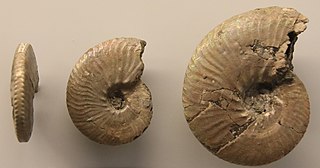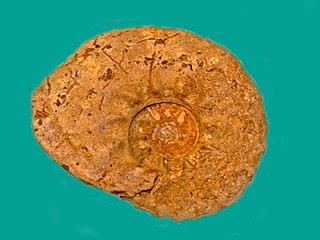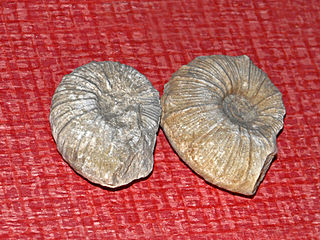Karapadites is an extinct ammonoid genus belonging to the desmoceratacean family Kossmaticeratidae and considered by some to be a subgenus of Kossmaticeras.
Aioloceras is an ammonite, order Ammonitida, from near the end of the Early Cretaceous. The shell is compressed with the outer whorl covering much of the previous. Sides are slightly convex, converge toward a narrowly ached venter. Inner whorls have sharp falcoid ribs, outer are smooth. Umbilical tubercles are lacking. Similar related forms include Neosaynella and Cleoniceras.
Algerites is middle Cretaceous (Cenomanian) anisoceratid ammonoid with a close-coiled adult shell in which the whorls at that stage are in close contact, after starting off with openly coiled whorls, and in which every rib has a pair of sharp ventral tubercles.
Anadesmoceras is an hoplitid ammonite from the lower Albian of England, included in the subfamily Cleoniceratinae. Anadesmoceras has a shell shaped more or less like a compressed Cleoniceras but with faint ornament only on the inner whorls. The shell has bundled growth striae. The aperture is preceded by several wide sinuous constrictions.

Anahamulina is an extinct ammonoid cephalopod genus from the Lower Cretaceous. Named by Hyatt, 1900.

Anahoplites is a genus of rather involute, compressed hoplitid ammonites with flat sides, narrow flat or grooved venters, and flexious ribs or striae arising from weak umbilicle tubercles that end in fine dense ventrolateral nodes. The elements of their sutures are short, wide and jaggedy. Specimens of Annahoplites have diameters typically in the range of 4–6 centimetres (1.6–2.4 in) although some with diameters of as much as 19 centimetres (7.5 in) have been reported. The genus lived during the Cretaceous, from the Middle to the late Albian.
Astiericeras is an ammonite from the Lower Cretaceous, the shell of which is evolute, stout; outer whorl with strong, well spaced, transverse ribs that cross smoothly over the broad venter; early whorls with lateral tubercles. The outer, mature whorl separates from the coil but hooks back quickly, referred to as a heteromorph.

Astieridiscus is an extinct lower Cretaceous ammonite. Its shell evolute, covered by dense, simple or branching, slightly flexuous ribs. The sides are slightly flattened, the venter rounded. No umbilical or other tubercles except on innermost whorl. Superficially resembles Olcostephanus.

Audaxlytoceras is an extinct genus of lytoceratid ammonites.

Argonauticeras is an extinct ammonoid cephalopod genus that lived during the latter part of the Early Cretaceous, included in the Lytoceratida and found in lower and possibly middle Aptian marine sediments. It has been thought of as a subgenus of Ammonoceratites.

Barremites is an ammonoid cephalopod genus belonging to the family Desmoceratidae, that lived during the Hauterivian and Barremian stages of the Early Cretaceous.

Barroisiceras is an acanthoceratacean ammonite from the Upper Cretaceous, Coniacian, included in the family Collignoniceratidae.
Beudantiella is a high whorled, compressed, sparsely ribbed ammonite from the Lower Cretaceous,, found in Queensland, Australia.
Bevahites is a Cretaceous ammonite with an evolute, ribbed, tuberculate, and keeled shell with a squarish to compressed whorl section.

Lytoceratinae is a subfamily of ammonoid cephalopods that make up part of the family Lytoceratidae.

Neocomites is a genus of ammonite from the Lower Cretaceous, Berriasian to Hauterivian, and type genus for the Neocomitidae.
Melchiorites is a desmoceratid ammonite genus included in the subfamily Puzosiinae. Member species are characterized by an essentially evolute shell in which the early whorls are smooth, with sinuous radial or oblique constrictions but in which later whorls have feeble intermediate ribs on the outer part of the sides and venter.

Kossmatella is an extinct genus of ammonoid cephalopods belonging to the family Lytoceratidae. These fast-moving nektonic carnivores lived in the Cretaceous period, from Albian age to Cenomanian age.

Hemihoplites is an extinct genus of ammonoid cephalopods belonging to the family Hemihoplitidae. These fast-moving nektonic carnivores lived in the Cretaceous period, from the Hauterivian age to the Barremian age.

Holcodiscus is an extinct ammonite genus placed in the family Holcodiscidae. Species in this genus were fast-moving nektonic carnivores. The type species of the genus is Ammonites caillaudianus.












